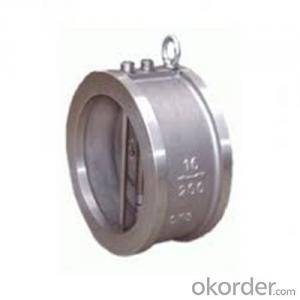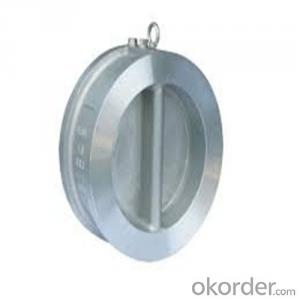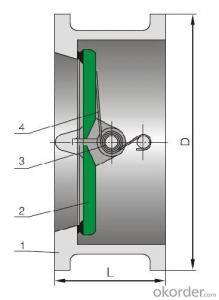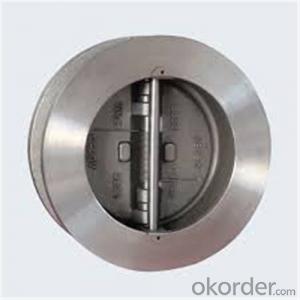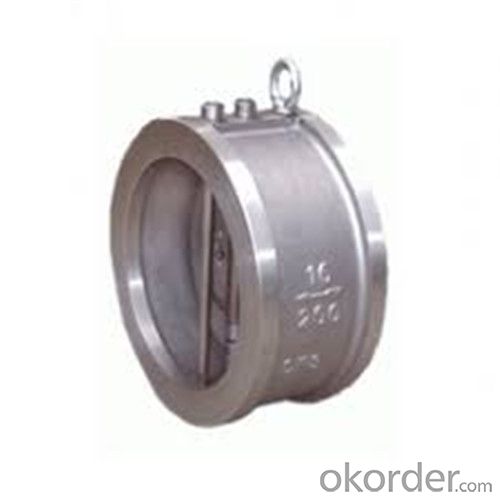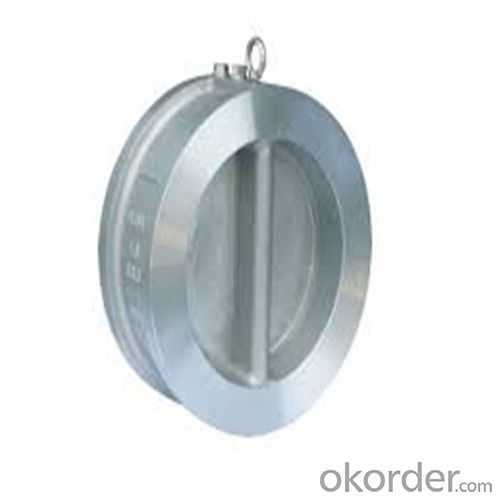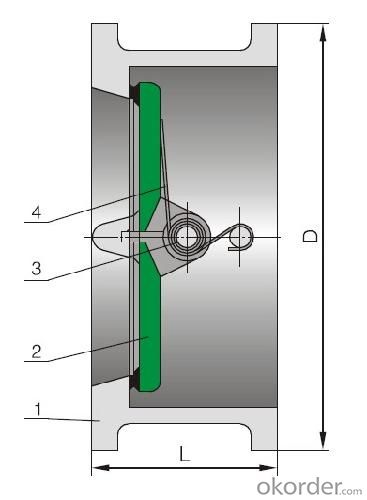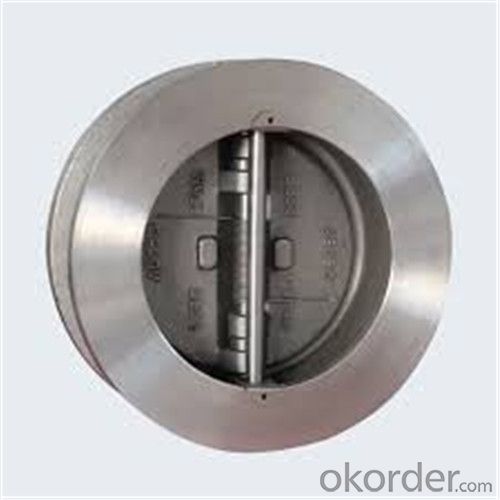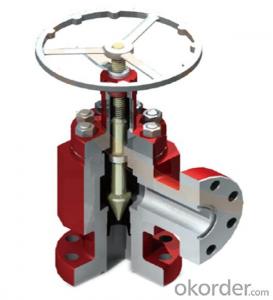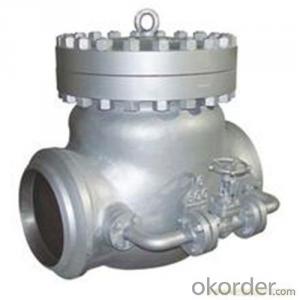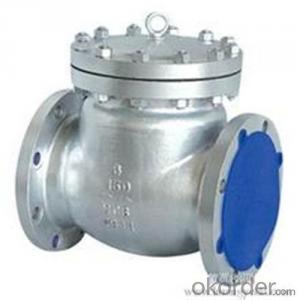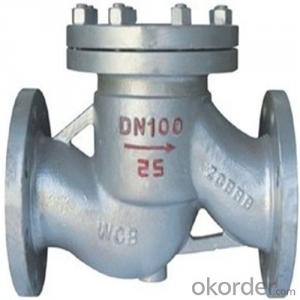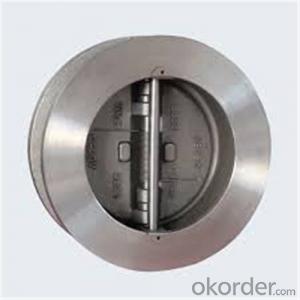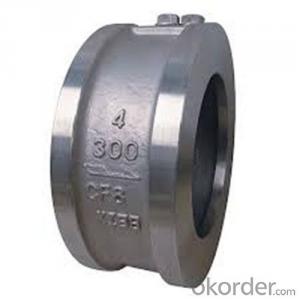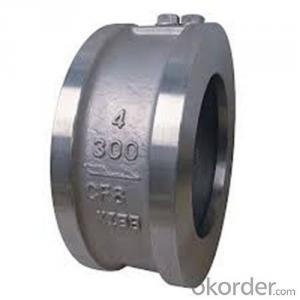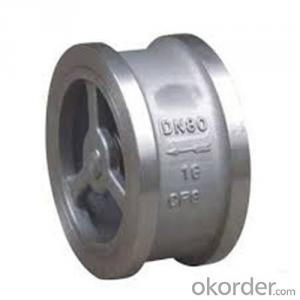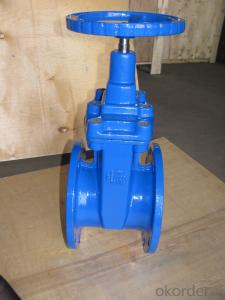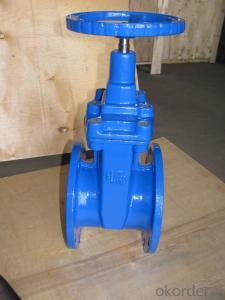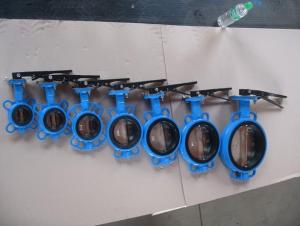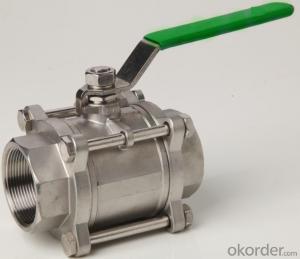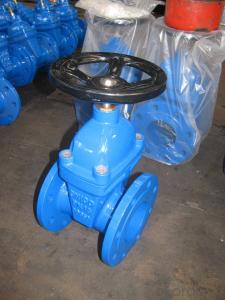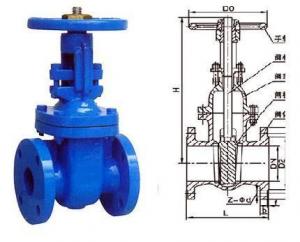Swing Check Valve Wafer Type Double Disc Body Material CF3
- Loading Port:
- Shanghai
- Payment Terms:
- TT OR LC
- Min Order Qty:
- 10 pc
- Supply Capability:
- 100 pc/month
OKorder Service Pledge
OKorder Financial Service
You Might Also Like
Products Description of Swing Check Valve
Check valves are used in pipes under pressures between PN1.6~16.0MPa(Class150~2500Lb), working temperatures-196~600℃, They are used in industries include oil, chemistry, pharmaceutical, fertilizer, and power gene-ration to prevent the backward flux of the media.
The main structure features of Swing Check Valve:
1、The products feature a reasonable structure, reliable seal, good performance and nice modeling.
2、Either soft or hard seal can be selected for the product upon different working conditions.The sealing face is built up with Co-based
carbide alloy, leaving a better wearability, corrosion and scrap resistance and a longer duration.
3、Small opening pressure, the disc can be opened fully with a very small pressure differential.
4、Inside-set bolt-bearing structure reduces leakage and reliable use.
5、PN≥16.0Mpa (class1500), the middle cavity uses a self-tightening sealing structure to have the sealing performance reinforced along
with the pressure rise so as to ensure the sealing performance.
6、Different parts materials and different sizes for flange, butt-welding are available for sensible combination according to different working facts and customers' requirements.
Parameter of Swing Check Valve:
Standard Criteria | GB customize |
Pressure Rating | 1 Mpa 1.6 Mpa 2.5 Mpa 4 Mpa 6.4 Mpa 10 Mpa 16 Mpa customize |
Valve Size | 50 mm 65 mm 80 mm 100 mm 125 mm 150 mm 200 mm 250 mm 300 mm 350 mm 400 mm 450 mm 500 mm 600 mm customi |
Actuator | Automatic customize |
Connection | Wafer customize |
Medium | Oil Steam Water customize |
Medium Temperature | -196~600℃ customize |
Structural style | Swing double-clack structure customize |
Application Fields | Agriculture Electricity Medical Petrochemical customize |
1-Body Material | CF3 CF8C CF8 WCB CF8M CF3M customize |
2-Disc | CF3 CF3M WCB CF8 CF8M CF8C customize |
3-Pivot | 1Cr13 1Cr18Ni9Ti 0Cr18Ni12Mo2Ti 2Cr13 customize |
4-Spring | 60Si2Mn 1Cr18Ni9Ti 4Cr13 0Cr18Ni12Mo2Ti customize |
Design Standard | GB/T 12224 customize |
Connection Standard | GB/T 9113 HG 20592 JB/T 79 customize |
Test Standard | JB/T 9092-1999 customize |
Face to Face | GB/T 15188.2-1994 customize |
Images of Swing Check Valve:
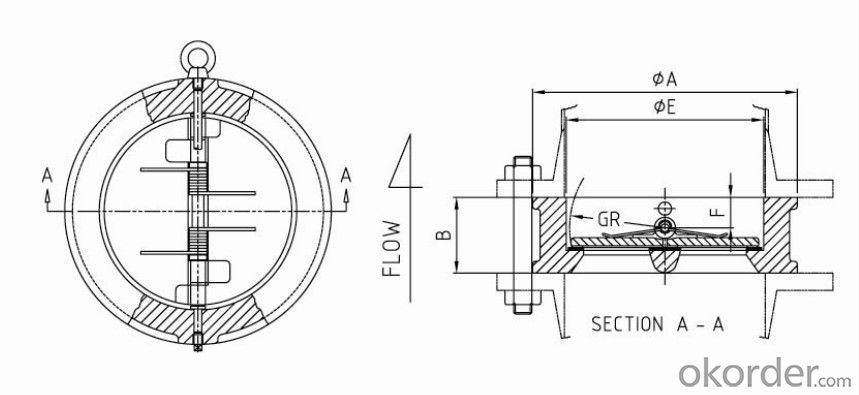

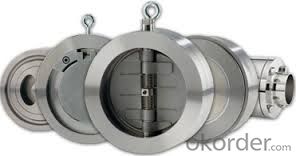
FAQ of Swing Check Valve:
Q1:I can’t find the type of steel check valve which I need. what can I do?
The chart above only lists out some common composition of steel check valve parts.We may provide other different parts material composition according to the customer's request or the actual valve working condition.
Q2:Which certification do your products pass?
Our products are in accordance with ISO 9001、ISO 14001、API 6A、API 6D、TS CE、API607/6FA/BS6755.
Q3:How can I place an order?
The only one thing you should do is to tell us the sepecification about type 、quantity and mode of transportation, then we will send you quotation within 24 hours.
- Q: 1998 Ford Crown Victoria LX 4.6L Use 89 Octane BP, Shell, Chevron gas. When the engine is under stress(acceleration or going up incline) the engine sounds like the valves are chattering. I can increase the rpm's and the chattering goes away. Had the same problem with 95 Thunderbird 4.6 and have heard other ford cars going down the road with this problem. Air leak? Don't really want to use higher octane due to gas prices and possible engine damage. Also, in the thunderbird, i used a bottle of octane boost and the next day a valve spring broke. Was the octane boost a possible cause?
- it is not valve chatter, it is called Pinging, it is a fairly common problem, what it is caused by is hot spots in the engine, or by overly advanced spark timing, i would check your base timing, perhaps even back it off a degree or two, i would also run a bottle of marvel mystery oil, or gm top engine cleaner through a vacuum line to burn out the crud that has built up, the sum total of these repairs: about 15 bucks, the savings: your engine! as for your t-bird, it was the pinging that broke the valve spring, not the tank of hi octane. hope this helps
- Q: My electric water heater relief valve keeps opening 30 min after turning it on.I turned it down to 90F and 30 min later overflow again.when power is off no leak with the water on uld the valve be opening because of over heating?I know it does'nt leak with cold running through it.
- Sometimes I find that the relief valve is not working correctly and needs to be replaced. They tend to get a buildup of minerals from the water that interferes with proper function.
- Q: I have a 97 Neon. The Canister Purge Valve circuit gives a code 31 stating that it has a problem. I've replaced the valve, which didn't make the code go away. I removed the battery for a few hours, and the code went away. I drove for about 2 weeks and the code came back on. If it's not the valve, where do I look next?
- Could you describe this canister purge valve? Not sure what you are talking about here. Is it part of the emissions, part of the radiator, or what. I am just guessing it's part of the emissions. In which case, I need to know if it has a smog pump. Could be the pump, could be a clogged up cat, could be a bad EGR valve. Need some more info to help beyond this point. Good luck.
- Q: i went to the heart doc today to get the results from an echocardiogram and he told me i had two leakages in one of the valves of my heart. i dont know why, but i didnt even bother to ask him exactly what that meant because he told me it was nothing to worry about. can anyone tell me more about this?
- Hum...it depends how bad your leakage is. If it causes too much blood to flow in the wrong direction it could cause an enlarged heart. What lead up to you having an echocardiogram? My son has has epstines malformation of the tricuspid valve and it caused leakage. It depends on the level of the leakage. It can be a big issue but obviously your leakages are small and nothing to be concerned with? I would def. call him and get some clarification....
- Q: My car may have warped valves. What does this mean? Can it be fixed? If so about how much? And how does this happen in the first place? Anything helps! Thanks!
- Warped Valves? I take it you are talking about the engine? {May you mean Bent Valve Steams?} is the Head(s) apart and you have seen this? If it is Bent Steams there is no fix, Replace Valves Valve Guides. [Did some guess at this? the only real way to tell is have the head(s) off]
- Q: Holding my right hand up, I am a newbie :) any help is greatly appreciated.a) Comparing the shape of the valve to a golf tee, what is the correct name for the thinnest section of the valve(the part of the golf tee that goes into the ground)b) What is the correct name for the widest section of the valve(the part of the golf tee that the ball is placed on.c) The cylinder that the valve moves up and down in, is it just called the valve cylinder?d) In the valve cylinder?, how does the widest part of the valve keeps things sealed. Does it use a ring(simmilar to pistons) or is it some type of gasket material or is it just zero clearance metal to metal.e) The section of the (valve cylinder?) that is above the seal point or basicaly where the valve spring and the thinnest part of the valve is, does oil flow through here?f) Do (valve cylinders?) generate enough heat to warrant the need for coolant?Newbie City, I know. Any help is GREATLY appreciated.TY
- a) The very end is the tip. Below that are grooves that the keepers lock into. This is actually the thinnest part. Below that is the rest of the stem. The general name for the largest part in total is the valve head. b) Surface sounds right. Hadn't really thought about it before. LOL c) Valve Guide. These can either be just a plain hole in the cylinder head material, or often they have bronze inserts. Plain Guides are often repaired by a process called knurling. d) Valves seal to the head by grinding each at the same angle, (usually 45 degrees) and then they are lapped which is where an abrasive compound is placed in between, and the valve is rotated. This matches the surfaces more closely yet. The parts that seal are called the valve face and the seat which is actually a separate part that is inserted into the head, and can be replaced. e) Oil is supplied to that general area, by either holes in pushrods that lubricate the rocker arm, or in the case of rockers mounted to a shaft, through the shaft. In the first case, oil is supplied by the hydraulic lifters. In the latter, the shaft pedestals are drilled for oil passages. In both cases, oil is present in the area, but is not applied directly to the valves. In fact, the job of the valve stem seal is to keep too much oil from getting in the guides. f) Usually the coolant flowing through the heads is enough to carry away the heat, although some hi-performance engines employ techniques such as hollow exhaust valves filled with sodium. Most normal valves are solid.
- Q: Hi.. I was looking forward to install an electric supercharger for my 2 litre non turbo engine.This unit is driven by an electric motor instead of being mechanically driven.My question is if I can install a blow off valve in between the supercharger and the inlet manifold? Will it work?
- You don't need a blow off valve. They create only 2lbs of boost which will not get your intake out of vacume, let alone produce pressure. The main efect they have is they mix the air and fuel better for better combustion. Weisco did make a prototype that produced 8 psi though!!! Can't wait for that one.
- Q: I took my 2nd valve out to wash it (i couldn't find my oil, but it worked fine) and I've tried making the number face the mouthpiece, yet it still is messed up and won't let me play a lot of notes.
- 1) Try this first and if this doesn't work, go to #2. Oil the valve's body and gently put it back into the cylinder without screwing it in yet. Then, turn the valve until it clicks, and make sure it is really seated correct. Some trumpets have two clicks, and one is not the right one. So, you have to get the right click - which tells you that your valve is seated right. When your valve is seated right, then screw it in. 2) If you don't get a click when you spin your valve - look at the tubing on your trumpet and line up the holes in your valve with the tubing. When the valve is up, it will line up with 2 holes of the tubing, and when it is down it will line up with 2 other holes in the tuning. So, you can determine the correct positioning of the valve by looking at the tubing on your trumpet. But this is a last resort. I've never seen a trumpet where the valves don't click when you turn them.
- Q: I need an angle valve for my sink buts its a bit of an odd size. I have copper tubing at 1/2 i need a valve preferably compression that can feed to a water supply that is 1/2 Pipe thread.Included images of the supply hose valve to sink. To help show what i'm looking for.
- If you're looking for a valve that attaches to a 1/2 iron pipe coming out of the wall, and then will feed to 1/2 copper tubing, then you're looking for- an angle stop, 1/2 female iron pipe to 1/2 compression. Just about any good hardware store will have it in stock or be able to order it, just be sure that they know what you need. I've often found that using visual aids,like a piece of pipe in one hand, and a piece of tubing in the other, with an empty space, waiting for a valve, between them, can be an invaluable aid to communication. Don't even try to cut and adapt a braided hose. The stainless braid contains a (relatively thin) rubber hose. Without the braid to reinforce it, it will burst. If you need to adapt plumbing, there is always a way to get water from point A to point B. The challenge is finding the most elegant route.
- Q: i hav no clue wat it is or what it does, but i was goin to buy an 08 mitsubishi lancer but then i read that the valve guides in mitsubishi engines wear out really fast and it causes some problems.what kinds of problems?how will this effect the car?Should i go ahead and buy the car?
- Worn valve guides can create a smoky oil burn on start-up, then once its warmed up, it seems to be okay, but thats with small block chevys. It will cause you to burn oil, thus needing to add oil on occasion. Also you have a potential for fouling sparkplugs. If you plan on keeping the car for awhile, its a concern, however if you're going to keep it for a few years, probably not a problem.
Send your message to us
Swing Check Valve Wafer Type Double Disc Body Material CF3
- Loading Port:
- Shanghai
- Payment Terms:
- TT OR LC
- Min Order Qty:
- 10 pc
- Supply Capability:
- 100 pc/month
OKorder Service Pledge
OKorder Financial Service
Similar products
Hot products
Hot Searches
Related keywords
